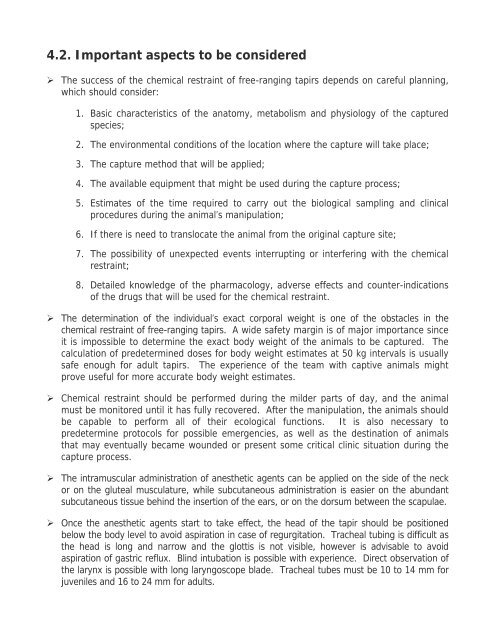TAPIR FIELD VETERINARY MANUAL - Tapir Specialist Group
TAPIR FIELD VETERINARY MANUAL - Tapir Specialist Group
TAPIR FIELD VETERINARY MANUAL - Tapir Specialist Group
You also want an ePaper? Increase the reach of your titles
YUMPU automatically turns print PDFs into web optimized ePapers that Google loves.
4.2. Important aspects to be considered<br />
� The success of the chemical restraint of free-ranging tapirs depends on careful planning,<br />
which should consider:<br />
1. Basic characteristics of the anatomy, metabolism and physiology of the captured<br />
species;<br />
2. The environmental conditions of the location where the capture will take place;<br />
3. The capture method that will be applied;<br />
4. The available equipment that might be used during the capture process;<br />
5. Estimates of the time required to carry out the biological sampling and clinical<br />
procedures during the animal’s manipulation;<br />
6. If there is need to translocate the animal from the original capture site;<br />
7. The possibility of unexpected events interrupting or interfering with the chemical<br />
restraint;<br />
8. Detailed knowledge of the pharmacology, adverse effects and counter-indications<br />
of the drugs that will be used for the chemical restraint.<br />
� The determination of the individual’s exact corporal weight is one of the obstacles in the<br />
chemical restraint of free-ranging tapirs. A wide safety margin is of major importance since<br />
it is impossible to determine the exact body weight of the animals to be captured. The<br />
calculation of predetermined doses for body weight estimates at 50 kg intervals is usually<br />
safe enough for adult tapirs. The experience of the team with captive animals might<br />
prove useful for more accurate body weight estimates.<br />
� Chemical restraint should be performed during the milder parts of day, and the animal<br />
must be monitored until it has fully recovered. After the manipulation, the animals should<br />
be capable to perform all of their ecological functions. It is also necessary to<br />
predetermine protocols for possible emergencies, as well as the destination of animals<br />
that may eventually became wounded or present some critical clinic situation during the<br />
capture process.<br />
� The intramuscular administration of anesthetic agents can be applied on the side of the neck<br />
or on the gluteal musculature, while subcutaneous administration is easier on the abundant<br />
subcutaneous tissue behind the insertion of the ears, or on the dorsum between the scapulae.<br />
� Once the anesthetic agents start to take effect, the head of the tapir should be positioned<br />
below the body level to avoid aspiration in case of regurgitation. Tracheal tubing is difficult as<br />
the head is long and narrow and the glottis is not visible, however is advisable to avoid<br />
aspiration of gastric reflux. Blind intubation is possible with experience. Direct observation of<br />
the larynx is possible with long laryngoscope blade. Tracheal tubes must be 10 to 14 mm for<br />
juveniles and 16 to 24 mm for adults.










